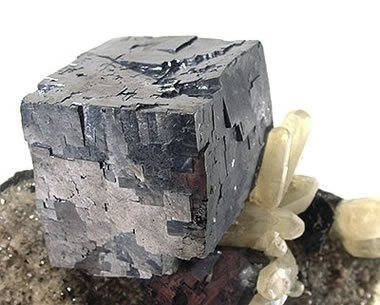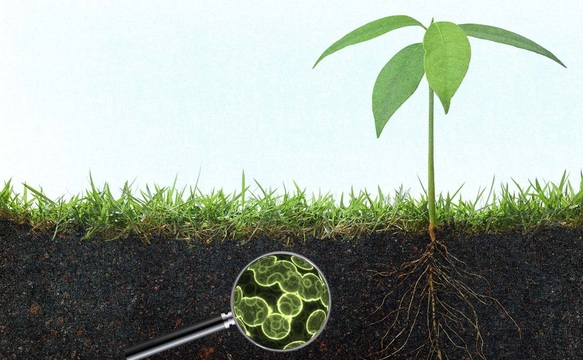- Endophytes for Heavy Metal Bioremediation - 04/12/2020
Human activity has affected every part of the biosphere – the soil is no exception. Agricultural and industrial practices have deteriorated soil health, impacting ecosystem function as well as food security. For the past two years, I have been working with the e-Seed Start-up to develop an innovative technique called endophytic inoculation, which uses naturally occurring endophytes (microorganisms that live in plant tissues) to improve plants’ resistance to stresses. Endophytic inoculation has a broad range of application, from maintaining and stimulating soil health to improving crop production and reducing the need for pesticides. In our most recent paper, we explored the possibility of using endophytes to enhance plants’ resistance to heavy metal-contaminated soil, paving the way for using endophytic inoculation to help detoxify soils polluted with heavy metals.
Cover image credit: http://modernfarmer.com/2014/04/microbes-will-feed-world-real-farmers-grow-soil-crops/
Heavy metals and Bioremediation
Heavy metals are defined by their high relative atomic weight (>4 g/cm3). Some of them such as zinc (Zn), iron (Fe), or manganese (Mn) are microelements that plants need and absorb with their roots because they are fundamental for the plant existence. However, in high concentrations these metals can be toxic. Other elements, such as lead (Pb), cobalt (Co) and arsenic (As) don’t have any biological function and are toxic even at low concentrations: they are classified as Toxic Heavy Metal (THM) [1,2].

Lead (Pb) is naturally present in rock formations in the Earth’s crust and becomes available on the surface through human activities. Ore extraction and battery recycling are the main source of lead, followed by agriculture practices (pesticides) and industrial products (pipe and dyes). Like other THMs, lead is non-biodegradable, and persists indefinitely in the environment. Indeed, it is possible to find lead in the atmosphere, hydrosphere and pedosphere, becoming easily absorbable by plants and microorganisms entering the food chain. In plants, lead causes germination and growth inhibition and can interrupt and interfere with biological reactions. In human, it causes mental retardation in children and acute or chronic damage in the neuronal systems, liver, kidney and gastrointestinal organs [3,4].
Nowadays, many methods are available to detoxify the environment from pollutants, however, they are generally very invasive and expensive. Some methods involve the use of chemicals, while others involve the extraction of polluted material (e.g. soil) from the original site and transporting it elsewhere for the detoxification. However, a more novel approach to detoxification is gaining momentum as an inexpensive and environmentally friendly alternative: Bioremediation.
Bioremediation is a branch of biotechnology that uses plants (Phytoremediation) or microorganisms (Microbial Bioremediation) to detoxify pollutants from substrates such as water, soil, etc. The principle is simple: plants and microorganisms are capable of immobilising or deactivating a pollutant reducing its bioavailability. They make the pollutant unavailable to be absorbed by plant roots and unable to enter water sources, the atmosphere or other substrates.

Below are a few ways in which plants reduce toxins’ bioavailability:
• Phytostabilization: the absorption and stabilization of the pollutant into the soil matrix or root wall. The pollutant is absorbed in the soil or the roots, so it cannot enter the plant, the food chain or any water source.
• Phytodegradation: chemical reactions which transform the pollutant into non- toxic products (mainly for organic pollutants).
• Phytoextraction: the extraction of the pollutant from the soil by plants or microorganisms, which then accumulate it in specialized structures such as the vacuole of the plant or the membrane of the microorganisms. This particular actions not only storage safely the pollutant, reducing its secondary effect on the plant, but also remove it from the soil restoring the natural equilibrium and health in the soil itself. [5]
Our Research
For our experiment [6], we isolated a consortium of endophytes from a grass species growing in lead-contaminated soil, and used it in association with a plant in a laboratory experiment to confirm their role in supporting and stimulating the plant growth in heavy metal-contaminated soil.
We collected a grass species, Agrostis stolonifera, from the abandoned mine site in Ballycorus, Co. Dublin, Ireland (see Figure 4). The site was used between the 18th and 19th centuries for extracting lead from the soil. Now, the natural vegetation has grown back, except on the main spoil heaps (SP02), as the ore extrication source, and the other two heaps (SP01 and SP04), which are smaller, solid-waste heaps [7].

Figure 4. The abandoned mine site in Ballycorus, Co. Dublin, Ireland
In the laboratory, plant material was used to isolate fungal endophytes. These endophytes were identified, and then used to inoculate seeds of another grass, Festuca arundinacea, which we grew in soils with different concentrations of lead. We measured germination and tillering rate (rate of producing side shoots) and, after harvesting, fresh and dry weight, and compared these to control grasses grown in the same soil but without an endophyte inoculation.

The results were very interesting. Overall, plants treated with endophytes germinated and tillered quicker and produced more foliar biomass compared the control set, showing the crucial role of endophytes in stimulating growth and reducing the negative effects of heavy metal in the plants. Moreover, we observed a statistically significance improvement in germination and tillering rate in plant endophytic treated at the highest concentrations of lead (800ppm). This suggests endophytes are particularly important for plant growth in the most heavily contaminated soils.
How endophytes promote growth and toxin-resistance remains unknown, but previous studies (see discussion [6]) suggest some possible mechanisms. Essentially, endophytes seem to reduce the bioavailability of lead, preventing it from entering the plant. Indeed, a study by Bibi et al. [8] described similar results. They inoculated lettuce with a consortium of endophytes and grew the crop in a cadmium-contaminated soil. An increase in biomass production of the lettuce was measured, which was associated with a reduction of accumulated metal in the edible part (the leaf). Indeed, they declared that the microorganisms were able to absorb the metal in their membrane, localising it at the root level.
Conclusions
Endoyphytes clearly have a role to play in helping plants resist the effects of toxic heavy metal. While their mechanism of action is still unclear, using natural microflora to enhance plant growth in contaminated soil and help detoxify polluted areas is an extraordinary possibility with a lot of potential. Quicker vegetation growth means a quicker restoration of the natural environment, helping protect and restore biodiversity (both in the soil and above it!) and even, where possible, allowing healthy crop production for humans. Our research is a step towards more sustainable living using ticks nature itself developed billions of years ago to mitigate and repair damage done to our soils.
References
1. Nagajyoti, P.C.; Lee, K.D.; Sreekanth, T.V.M. Heavy metals, occurrence and toxicity for plants: A review. Environ. Chem. Lett. 2010, 8, 199–216, doi:10.1007/s10311-010-0297-8.
2. Rahman, Z.; Singh, V.P. The relative impact of toxic heavy metals (THMs) (arsenic (As), cadmium (Cd), chromium (Cr) (VI), mercury (Hg), and lead (Pb)) on the total environment: an overview. Environ. Monit. Assess. 2019, 191, 419, doi:10.1007/s10661-019-7528-7.
3. Singh, R.; Gautam, N.; Mishra, A.; Gupta, R. Heavy metals and living systems: An overview. Indian J. Pharmacol. 2011, 43, 246–253, doi:10.4103/0253-7613.81505.
4. Shama, P.; Dubey, R.S. Lead toxicity in plants. Brazilian J. Plant Physiol. 2005, 17, 35–52, doi:10.1590/S1677-04202005000100004.
5. Favas, J.C.P.; Pratas, J.; Varun, M.; D’Souza, R.; Paul, M.S. Phytoremediation of Soils Contaminated with Metals and Metalloids at Mining Areas: Potential of Native Flora. In Environmental Risk Assessment of Soil Contamination; 2014; pp. 485–517.
6. Soldi, E.; Casey, C.; Murphy, B.R.; Hodkinson, T.R. Fungal endophytes for grass based bioremediation: An endophytic consortium isolated from agrostis stolonifera stimulates the growth of festuca arundinacea in lead contaminated soil. J. Fungi 2020, 6, 1–15, doi:10.3390/jof6040254.
7. Mhairtin, N.F.; Stanley, G.; Gallagher, V.; Brogan, J. Geochemistry Solid Waste Data for the Historic Mine Sites Project – Inventory and Risk Classification, Volume 1; 2009; Vol. I;
8. Bibi, S.; Hussain, A.; Hamayun, M.; Rahman, H.; Iqbal, A.; Shah, M.; Irshad, M.; Qasim, M.; Islam, B. Bioremediation of hexavalent chromium by endophytic fungi; safe and improved production of Lactuca sativa L. Chemosphere 2018, 211, 653–663, doi:10.1016/j.chemosphere.2018.07.197.

